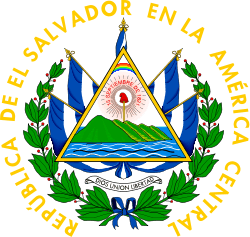Elections in El Salvador
 |
| This article is part of a series on the politics and government of El Salvador |
|
|
Politics portal |
Elections in El Salvador gives information on elections and election results in El Salvador.
Electoral system
El Salvador elects its head of state – the President of El Salvador – directly through a fixed-date general election whose winner is decided by absolute majority. If an absolute majority (50% + 1) is not achieved by any candidate in the first round of a presidential election, then a run-off election is conducted 30 days later between the two candidates who obtained the most votes in the first round. The presidential period is five years and consecutive re-election is not permitted, though previously elected presidents may run for a second, non-consecutive term.
Salvadorans also elect a single-chamber, unicameral national legislature – the Legislative Assembly of El Salvador – composed of 84 members (deputies) elected by open-list proportional representation for three-year terms, with the possibility of immediate re-election. All 84 seats in the Legislative Assembly are elected on the basis of 14 multi-member constituencies (corresponding to the country's 14 departments) that range from 3-16 seats each according to department population size.
El Salvador has a multi-party system, although two political parties, ARENA and the FMLN have tended to dominate elections, with ARENA candidates having won four consecutive presidential elections until the election of Mauricio Funes of the FMLN in March 2009.
Schedule
Election
| Position | 2012 | 2013 | 2014 | 2015 | 2016 | 2017 |
|---|---|---|---|---|---|---|
| Type | Gubernatorial (March) National Congress (March) | None | Presidential (March) | National Congress (March) Gubernatorial (March) | None | |
| President and vice president |
None | President and vice president | None | |||
| National Congress | All seats | None | All seats | None | ||
| Provinces, cities and municipalities | All positions | None | All positions | None | ||
Inauguration
| Position | 2012 | 2013 | 2014 | 2015 | 2016 | 2017 |
|---|---|---|---|---|---|---|
| Type | Gubernatorial (June) National Congress (June) | None | Presidential (June) National Congress (June) | None | ||
| President and vice president |
None | 1 June | None | |||
| National Congress | 1 May | None | 1 May | None | ||
| Provinces, cities and municipalities | 1 May | None | 1 May | None | ||
Latest elections
| Party | Votes | % | Seats | +/– | ||
|---|---|---|---|---|---|---|
| Nationalist Republican Alliance (Alianza Republicana Nacionalista) | 870,418 | 39.76% | 33 | |||
| Farabundo Martí National Liberation Front (Frente Farabundo Martí para la Liberación Nacional) | 804,760 | 36.76% | 31 | |||
| Grand Alliance for National Unity (Alianza por la Unidad Nacional) | 210,101 | 9.6% | 11 | |||
| National Coalition (Concertación Nacional)1 | 157,074 | 7.18% | 74 | |||
| Party of Hope (Partido de la Esperanza)2 | 60,486 | 2.76% | 14 | |||
| Democratic Change (Cambio Democrático) | 46,838 | 2.14% | 1 | |||
| National Liberal Party (Partido Nacional Liberal) | 14,379 | 0.66% | 0 | |||
| People's Party (Partido Popular) | 10,952 | 0.50% | 0 | |||
| Independents3 | 14,098 | 0.63% | 0 | |||
| Totals | 2,215,589 | 100.00% | 84 | — | ||
| 1Compared to National Conciliation Party in 2009. 2Compared to Christian Democratic Party in 2009. 3Five independent candidates. Percentage and votes are cumulative. 4A MP from Chalatenango that won, ran on a joint CN and PES ticket and got 17,072 votes, or 0.78% (counted here for CN). Source: Supreme Electoral Tribunal | ||||||
| Candidate | Party | First round | Second round | ||
|---|---|---|---|---|---|
| Votes | % | Votes | % | ||
| Salvador Sánchez Cerén | Farabundo Martí National Liberation Front | 1,315,768 | 48.93 | 1,495,815 | 50.11 |
| Norman Quijano | Nationalist Republican Alliance | 1,047,592 | 38.96 | 1,489,451 | 49.89 |
| Antonio Saca | Unity Movement | 307,603 | 11.44 | ||
| René Rodriguez Hurtado | Salvadoran Progressive Party | 11,314 | 0.42 | ||
| Óscar Lemus | Salvadoran Patriot Fraternity | 6,659 | 0.25 | ||
| Invalid/blank votes | 34,310 | – | 19,579 | – | |
| Total | 2,723,246 | 100 | 3,004,845 | 100 | |
| Registered voters/turnout | 4,955,107 | 54.96 | 4,955,107 | 60.64 | |
| Source: TSE 1, | |||||
See also
- Electoral calendar
- Electoral system
References
| ||||||||||||||
| |||||||||||||||||||||||||||||||||||||||||
| ||||||||||